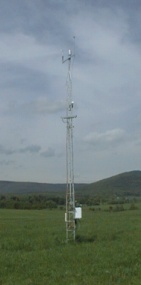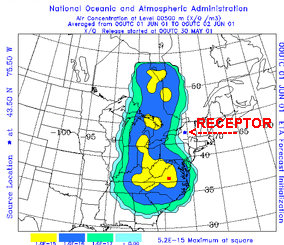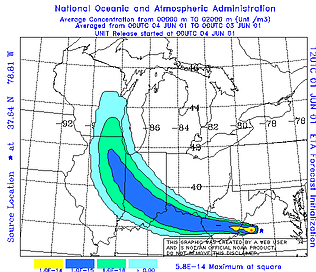
Source Attribution MethodsTransport Modeling & Assessment Group - Silver Spring, MD
One common approach is the calculate the trajectory "backwards" from the receptor site. In the HYSPLIT trajectory calculation this is accomplished by setting the integration time step to a negative value. However the trajectory only represents the upwind path of a single point, while the pollutant measurement may require of hundreds or thousands of trajectories to represent the dispersion of the pollutant in time and space. One solution to this problem would be to calculate concentration contributions from a matrix of sources and then use hybrid receptor modeling methods in combination with the fractional contribution from each source to the measured concentration at the sampling location to determine the source location.
Another approach would be to run the HYSPLIT dispersion-trajectory model "backwards". In a 3D particle model the dispersion process is represented by a turbulent component added to the calculation and therefore it is computationally attractive because the advection process is fully reversible. The trajectory equation can be correctly integrated in either direction. However, the interpretation of the output is a bit more complex because dispersion is an irreversible process. The equivalent backward numerical calculation will yield a result because the integration of the dispersion equation is still in the normal downstream mode (dispersing particles rather than converging particles) on top of the backward upstream integration of the advection. The meaning of the upwind dispersion result is less clear. One interpretation is that although the calculation can disperse material upwind, more or less equally in all directions from the measurement point, one really doesn't know from which direction the pollutant is coming without the contribution from the reversible advection term. For example, from measurements taken on a mountain top, no model will be able to determine if the pollutant measured at the sampler is mixing up from the valley below or is being advected to the site aloft from a more distant location. The true solution is a function of the geometry of the source location with respect to the measurement site as well as the characteristics of the dispersion at the measurement site. The reason many of these approaches seem to work is that the process is dominated by the advection term and not the diffusion part of the solution. |

 Source-Receptor Matrix
Source-Receptor Matrix
 "Backward" Dispersion
"Backward" Dispersion